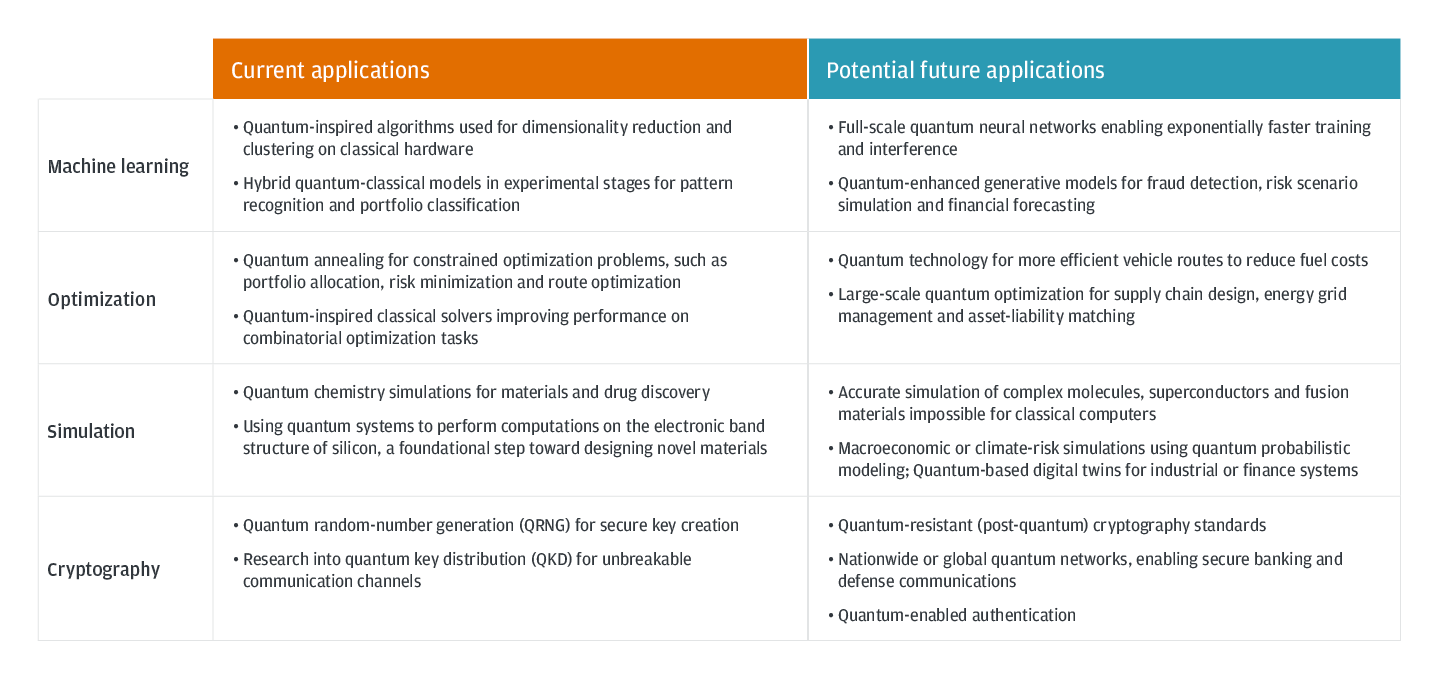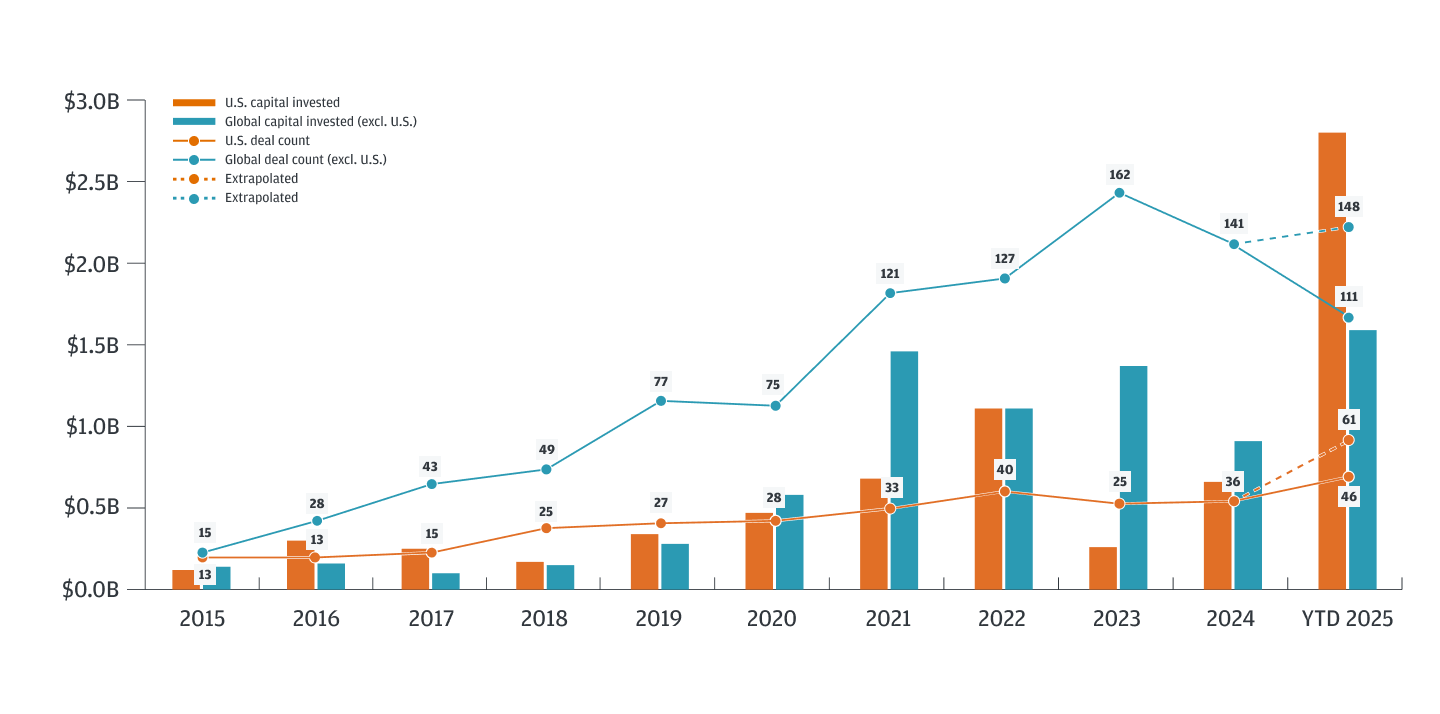Note: The current quantum applications listed above are aggregated from publicly available sources and industry analyses, without reference to any specific company or product. The potential future applications are hypothetical and intended for illustrative purposes only; their realization is not guaranteed.

8 min read
Over the past several decades, the world has witnessed extraordinary leaps in computational capability. Each new wave of technological innovation has built upon the achievements of its predecessors. The computing power of each smartphone far surpasses early computers, reflecting the remarkable possibilities unlocked through collective ingenuity and innovation.
An exciting era of transformation is upon us—one where quantum technologies have the ability to provide significant advancements in computing, sensing and communication security. This transformation is propelled by governments, corporations, universities and investors. As quantum systems move beyond academic and experimental curiosities to early industry-grade solutions, the current quantum era marks a pivotal transition toward niche yet tangible applications in real business contexts.
What is quantum technology?
Quantum technology builds on the principles of quantum mechanics, the branch of physics that emerged in the early 20th century to explain the behavior of matter and energy at the smallest scales. Early experiments revealed that particles could exhibit both wave- and particle-like properties, a discovery that laid the foundation for many modern technologies, from nuclear power to semiconductors.
Quantum computing is broadly understood to be the central pillar of quantum technologies, alongside quantum sensing and quantum communications.
- Quantum computing harnesses qubits’ superposition and entanglement to tackle problems beyond classical reach—powering advances in cryptography, optimization, drug discovery and more.
- Quantum sensing exploits the extreme sensitivity of quantum states for ultra-precise measurements—enabling next-generation MRI, GPS-free navigation, resource exploration and environmental monitoring.
- Quantum communications uses techniques including quantum key distribution to detect eavesdropping and protect privacy—laying the foundation for unbreakable encryption in financial, government and defense networks.
From lab to market: Industry applications on the horizon
Quantum technology is rapidly evolving. Much like the internet’s pre-dot-com era when foundational technologies were being built but mainstream adoption had yet to occur, ongoing research and development efforts in quantum computing are laying the groundwork for transformative change. As progress is made from noisy, limited devices to scalable and reliable machines, quantum systems appear poised to expand beyond niche applications.
Present and potential future use cases and applications underscore the breadth of opportunities across global industries. A 2025 survey of 500 business leaders found that roughly 3 in 5 enterprises are exploring opportunities in quantum—particularly in quantum AI, which brings together quantum computing and AI to develop new algorithms, models and systems to solve problems considered challenging or impossible with traditional computers.1
Quantum industry applications

“While real-world applications are still emerging, we see significant future opportunities to leverage quantum technology for optimization and modeling or simulation-style problems.”
Scot Baldry
Global Chief Technology Officer, JPMorganChase
Quantum venture activity
Global investment in quantum technologies has skyrocketed 17-fold over the past decade. As of Q3, 2025 is already the most active year ever for quantum venture investment.
The United States is at the forefront of quantum venture activity, with $2.8 billion invested in U.S.-headquartered quantum startups through 3Q 2025. In comparison, startups based outside the U.S. have attracted $1.6 billion in investment. Highlighting the concentration of funding among a small number of players, just three companies raised approximately $2.0 billion of the U.S. total.
Global quantum venture activity

Note: YTD 2025 is as 9/30/2025. Of the approximately $2.8 billion of quantum venture investment in the U.S. through YTD 2025, roughly $2.0 billion was cumulatively raised by three companies. Source: PitchBook. Data has not been reviewed by PitchBook analysts.
Among quantum startups funded over the last decade, some key themes have emerged:
- Development of scalable quantum computing hardware, including superconducting, trapped ion, silicon-based and photonic architectures, with an emphasis on error correction and fault tolerance
- Creation of quantum software platforms, cloud services and algorithm libraries to enable practical applications in drug discovery, materials science and finance
- Advancement of quantum cybersecurity solutions, such as quantum-resistant encryption, quantum key distribution, secure messaging and blockchain protection
- Innovation in quantum sensors and imaging technologies for medical diagnostics, environmental monitoring and navigation, leveraging quantum effects for greater precision
- Expansion of quantum networking and communications infrastructure, including quantum repeaters, secure links and quantum internet prototypes
- Production of quantum materials and photonics, including quantum dots for displays and sensors, photonic chips, superconductors and advanced nanomaterials for energy and sensing
Where quantum technology is today
Timelines for reaching practical quantum computers are strongly debated. Part of this debate centers on the definition of practical quantum computing itself. For most, the system would need to offer a broad quantum advantage—meaning a quantum computer outperforms classical computers over a range of useful problems—and attain full-scale fault-tolerant quantum computing (FTQC). A quantum computer would also need to be capable of running accurate and reliable computations for arbitrarily long periods.
Achieving commercially available, practical quantum computing faces several major challenges:
- Scaling up the number of usable (logical) qubits while reliably preserving their quantum states; for example, qubit stability—the ability of quantum bits to maintain their delicate quantum states—is often threatened by noise or unwanted disturbances within quantum systems.
- Developing efficient and robust error correction methods.
- Ensuring seamless integration between quantum and classical computing systems.
- Competing for talent given the scarcity of professionals who possess expertise in both quantum mechanics and computer science.
Unlike big technology companies that have significant capital and resources to allocate to in-house quantum initiatives, startups are reliant on equity financing to meet substantial capital needs.
The capital-intensive nature of the sector motivated a cohort of quantum startups to go public during the 2021 to 2022 period, with most opting for a reverse merger. Although this group had raised nearly $600 million in private markets, access to larger pools of capital was necessary. To date, this cohort has raised approximately $3.4 billion from public market investors.
The federal government also plays a vital role in advancing the industry through grants and contracts. The National Quantum Initiative Act (NQI Act), established in 2018, had a five-year budget of over $1.2 billion. This is in addition to baseline government funding for quantum information science (QIS), an interdisciplinary field that merges quantum mechanics with information theory and computer science.
U.S. R&D budgets for QIS since the inception of the NQI Act

Note: The bar heights represent the total budget for each fiscal year (FY 2019 – FY 2023 actual expenditures, FY 2024 estimated expenditures, and FY 2025 budget request). The portion of each bar marked “NQI funding” identifies funding allocated for NQI Act-authorized activities; this additional funding is on top of the budgets for baseline QIS R&D activities. Source: https://www.quantum.gov/
In addition to grants, contract awards are critically important for quantum startups to hone the technology on real-world use cases. Several government entities including the Defense Advanced Research Projects Agency, the Department of Energy and Air Force Research Laboratory, have quantum initiatives and have issued contracts ranging from a few hundred thousand to tens of millions of dollars. Contracts’ focuses include quantum networking and hardware, exploring space-based applications, optimizing inventory management, advancing fault-tolerant quantum computing through logical qubits, and developing quantum-resilient encryption, as well as supporting general quantum research.
Where quantum technology is headed
The year 2025 marks the 100th anniversary of quantum mechanics. In recognition, the United Nations has declared it the International Year of Quantum. A century of progress has brought milestones that early pioneers could not have imagined. Looking ahead, quantum could underpin the next major technological paradigm—much like semiconductors did in the mid-20th century and cloud computing in the early 21st. The timeline for widespread adoption remains uncertain, but the trajectory is demonstrably clear: Progress is accelerating across hardware, algorithms and applications.
As the field transitions from research to realization, academic breakthroughs alone will not bring quantum to market—it will take entrepreneurial execution, capital formation and ecosystem coordination. Governments will likely continue to fund foundational research, but the next phase of value creation will hinge on translating scientific insight into scalable products: quantum-safe cryptography, precision sensing and simulation-driven design. For investors and innovators alike, the coming decade represents both a frontier and a test—of patience, conviction and imagination.
References
Survey conducted by data and AI provider SAS, “Quantum leap: three out of five businesses are exploring quantum AI, per SAS survey,” news release, May 2025, SAS, https://www.sas.com/en_us/news/press-releases/2025/may/quantum-ai.html
Contributors

Justin Krauss
Head of Applied Tech Banking

Norma Padron
Vice President, Commercial Banker
JPMorgan Chase Bank, N.A. Member FDIC. Visit jpmorgan.com/commercial-banking/legal-disclaimer for disclosures and disclaimers related to this content.






